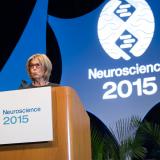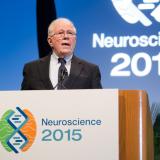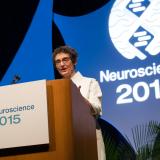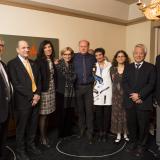2015 Gruber Neuroscience Prize
Neuroscientists Carla Shatz, PhD, of Stanford University and Michael Greenberg, PhD, of Harvard Medical School are honored for their landmark discoveries regarding the molecular mechanisms through which neural activity controls wiring and plasticity of the brain.
In her pioneering studies, Shatz demonstrated how neural activity is required for the refinement of connections in early brain development. She also discovered new and unexpected roles for immune molecules in brain circuit tuning and plasticity. Through his groundbreaking research, Greenberg identified how genetic programs are triggered by experience-stimulated neuronal activity. He has also described many of their critical molecular mechanisms and signaling pathways.
2015 Neuroscience Prize Recipients
Laureate Profile
Michael Greenberg, PhD, Chair of the Department of Neurobiology and the Nathan Marsh Pusey Professor of Neurobiology at Harvard Medical School, has spent the last 30 years unlocking the mysteries of the molecular mechanisms that underlie the effects of experience on the brain thus elucidating how nature and nurture are intertwined during brain development. In 1984, he made the landmark discovery that growth factors send signals from the cell surface to the nucleus thereby instructing cells to transcribe the c-fos gene. Since then Greenberg and other researchers have shown that this process is induced in neurons in response to neural activity, and have identified hundreds of genes in addition to c-fos that are activated in the brain in response to sensory stimuli. Greenberg has described in elegant detail the neural pathways of this transcription process, including how the “L-type” voltage-gated Ca2+ calcium channel leads to gene expression crucial for synapse development and for learning and memory. Working with cultured mouse neurons, Greenberg recently demonstrated that “enhancer regions” of DNA across the genome are not only activated by sensory stimuli, but also create strands of enhancer RNA (eRNA) that play a role in the neuron’s response to an external stimulus. More recently, Greenberg has reported that the lack of one crucial regulator of sensory-dependent gene expression, MeCP2, results in disruption of the expression of long genes in the brain, a finding with profound implications for the developmental disorder, Rett syndrome, and other neurological disorders.
Carla Shatz, PhD, the David Starr Jordan Director of Bio-X and the Sapp Family Provostial Professor of Biology and Neurobiology at Stanford University, has been a pioneer in discovering and understanding what happens during critical periods of brain development, both before and after birth. She was the first to demonstrate that the visual system in the mammalian brain is not hardwired, but shaped even in utero by spontaneous “waves” of neural activity that prune and strengthen neural connections. She also made the groundbreaking discovery that MHC (major histocompatibility) Class I genes play a major role in this synaptic remodeling. At the time, MHCI proteins were known only for their role in the immune system, but she found that they are also present in nerve cells. Other major discoveries by Shatz include the finding that MHCI molecules interact with another immune system molecule shared with neurons, the PirB receptor. By removing PirB receptors from the brains of mice with Alzheimer’s disease, Shatz demonstrated that the animals did not develop the disease. These and other findings have opened entirely new avenues of research into the causes and treatment of Alzheimer’s disease, stroke, and other devastating brain diseases.
Citation
The Gruber Foundation proudly presents the 2015 Neuroscience Prize to Carla Shatz and Michael Greenberg for their elucidation of the molecular mechanisms through which neural activity controls wiring and plasticity of the brain.
Shatz’s pioneering studies showed that neural activity is needed for the refinement of connections in early brain development and revealed an unexpected role for immune signaling in neurons.
Greenberg discovered that the “L-type” voltage-gated Ca2+ channel couples membrane excitability to gene transcription, elucidating in elegant detail the signaling pathways responsible.
Together their ground-breaking studies have provided new insight into how neural circuit function regulates brain development and plasticity and how dysfunction can contribute to neuropsychiatric disorders such as autism and schizophrenia.



















































